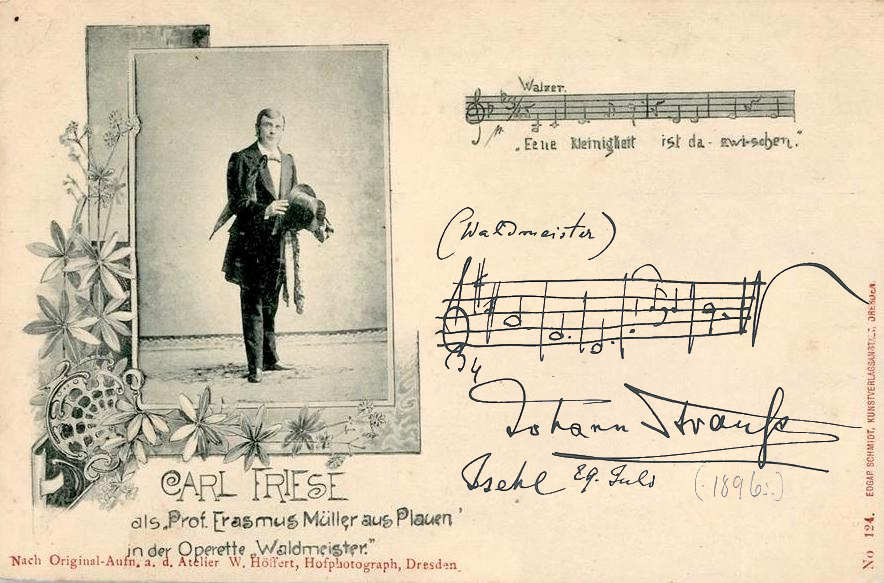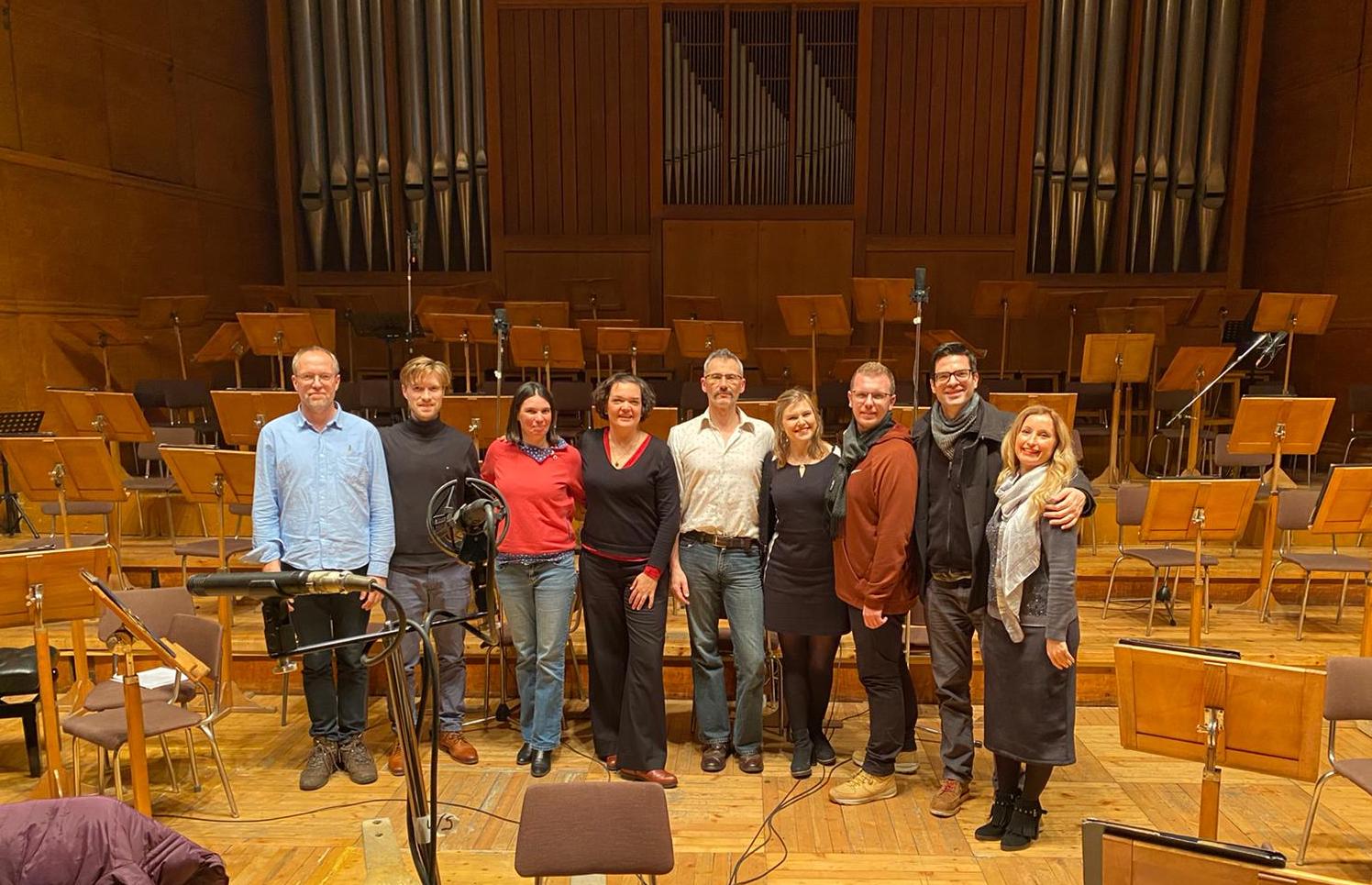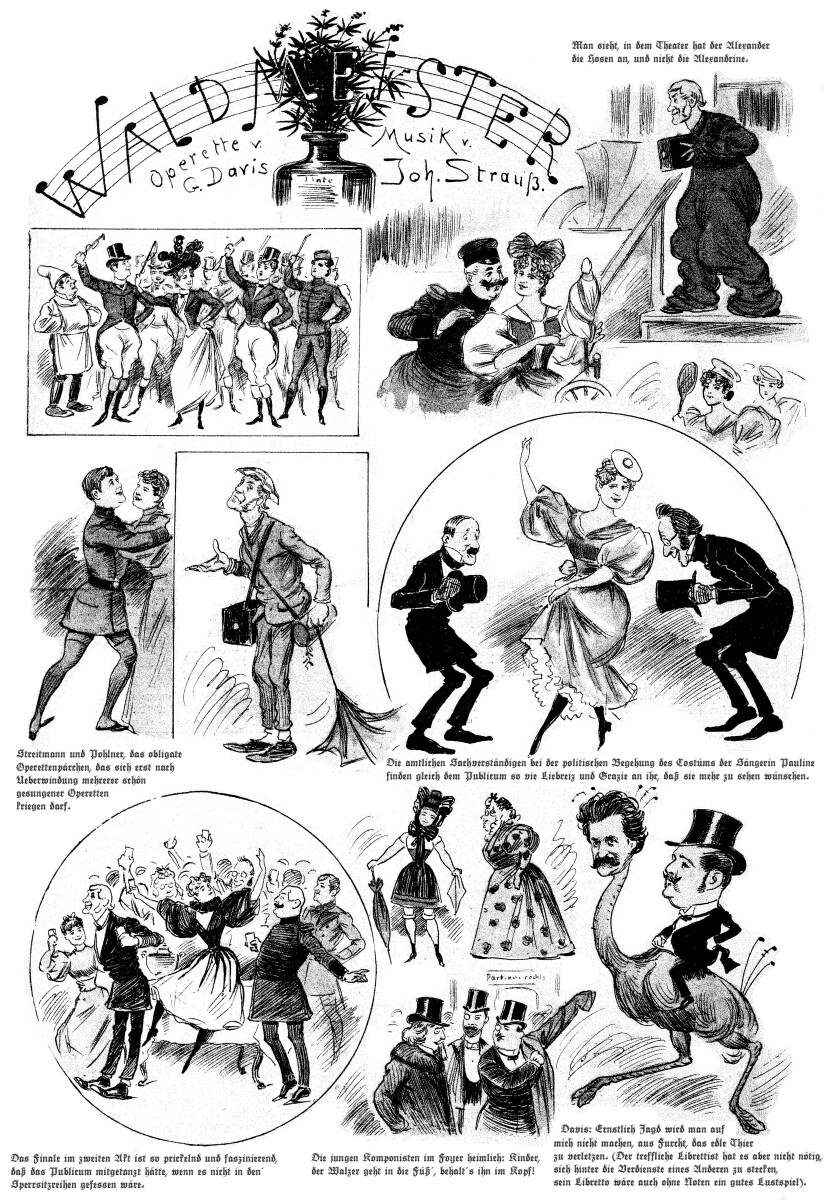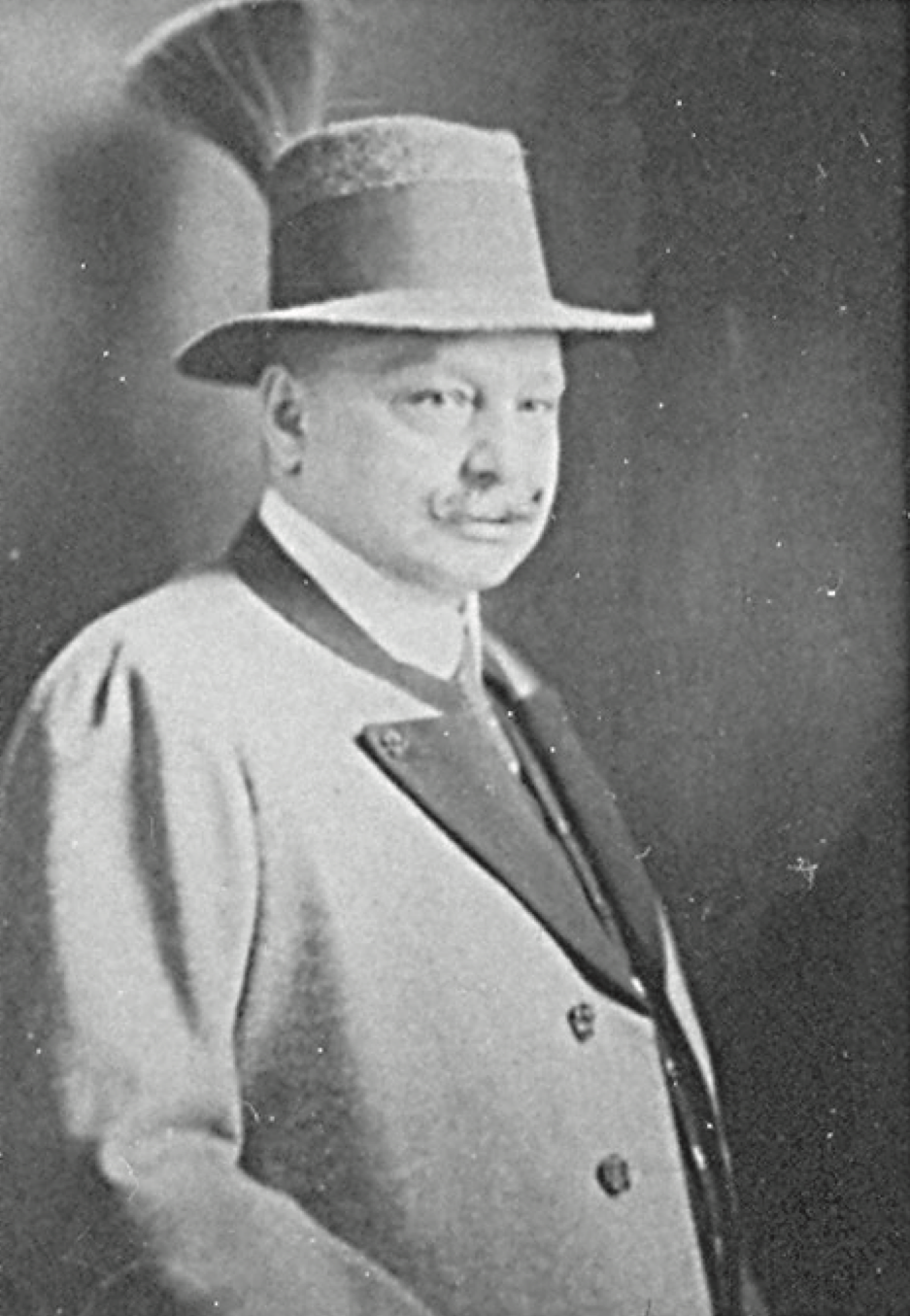Kevin Clarke / Yonel Buldrini
Operetta Research Center
28 August, 2021
The label Naxos is continuing its Johann Strauss series with a new recording of late operetta Waldmeister, which originally premiered in 1895 at Theater an der Wien. It had Alexander Girardi as the star, and Josef Josephi as the second big name, plus Marie Ottmann. The production managed 88 performances back then, but then the title mostly disappeared. Now, Dario Salvi reconstructed the performance material and recorded it in January 2021 – during lockdown! – at the Bulgaria Hall in Sofia. Here is Yonel Buldrini somewhat “overenthusiastic” account of the recording sessions. It reads like a fan letter… but it contains most of the relevant information. (We’ve kept the full unedited original text and hope the unfiltered adoration puts a smile on your face.)

Carl Friese in “Waldmeister” as seen on a postcard from Ischl. (Photo: Dario Salvi Collection)
With the dazzling Waldmeister, Naxos brings back to light a fourteenth operetta by Johann Strauss, out of the fifteen he composed. The only one left to know is Indigo und die 40 Räuber, of which we had a foretaste with the old Urania recording of his pastiche Tausend und eine Nacht, superbly conducted by Otto Dobrindt, and by some excerpts from the French version La Reine Indigo, performed on French Radio.
After Blindekuh, already a great success, Naxos offers us Waldmeister, whose sumptuous music deserves our full attention… and that of the theatres of the World!
We can recognize with emotion all the motifs that already lulled us in the beautiful overture, and in the six symphonic pieces skillfully composed by Johann Strauss from the motifs of his operetta. These include the irresistible march “Es war so wunderschön” and the ineffable waltz “Trau’, schau’, wem!” which is the leitmotif of the work and which we hear again and again with the same delight.
But any musical composition, however beautifully achieved, needs performers who are equal to it, unlike other works of art, such as paintings or literary works, which are created once and for all!

Johanna Frey as Malwine in the 1895 premiere of “Waldmeister” at Theater an der Wien. (Photo: Rudolf Krziwanek / Theatermuseum Wien)
And the great Artisan of the success of this Waldmeister is the “Meister”, precisely! Maestro Dario Salvi, whose attentive, refined, alternately restrained and fiery conducting marvellously serves the composer’s intentions and does justice to his beautiful music.

Conductor Dario Salvi (center) and the “Waldmeister” cast during rehearsals in Sofia. (Photo: Dario Salvi Collection)
An example that speaks for itself shows both the art of Johann Strauss and the art of Maestro Salvi, who chisels out the overall performance: here we are at the end of Act II, and we still haven’t heard the superb main motif of the waltz “Trau’, schau’, wem”! Op. 463. Now, at the moment of the grand Finale II, Johann Strauss plays another motif from his waltz, one from the march “Es war so wunderschön”, another from the overture… then we feel the main motif coming, exactly as in the overture… the introduction of the waltz… but nothing! We start again on another moment from the overture: Johann Strauss is making us languish!

Marie Ottmann as Pauline in the world premiere of “Waldmeister” at Theater an der Wien. (Photo: Rudolf Krziwanek / Theatermuseum Wien)
Here is another waltz motif… Finally, the main motive appears, sung by the contralto Malwine, but instead of bursting out, luminous, rich, it is softly taken up by the other characters: the Composer distils sparingly this treasure of his main motive… Come on ! another motif and the waltz… Ah! the main motive returns, but still gently, concluded by a clear orchestral chord, sounding almost final! And yet the main motive creeps in, shows its nose, without really declaring itself, without blossoming as in the well-known op. 463, it suggests itself… But suddenly the orchestra roars… we say to ourselves: “this time it’s here!…” and all the more so as the characters cry out “Zum Tanze!” (To the dance!)… and indeed, all the characters and the entire orchestra launch into this great motif and give us a delicious thrill!

Scenes from “Waldmeister” as seen in a historic cartoon. (Photo: Dario Salvi Collection)
The whole construction of Johann Strauss, who distils his musical findings instead of throwing them to the hungry listeners, is reconstructed step by step by Maestro Salvi, and with such precision and nuance that one would think he had been “briefed” by Johann Strauss himself!
I will not go into detail about the plot, which is actually quite nice (and much simpler than that of Blindekuh!), because it is very well described and commented on in the Naxos recording booklet, but one can at least underline its originality, revolving around the famous woodruff plant, which gives its German name of “Waldmeister” to the operetta, and whose mischievous decoction will intoxicate everyone in the Finale of the second act!

Karl Streitmann as Tymoleon von Gerius, forest intendant, in “Waldmeister” 1895. (Photo: Mertens, Mai & Cie. / Theatermuseum Wien)
Moreover, the long and patient work of reconstituting and recording the original score,made possible by the unfailing support of Nayden Todorov, musical Director of the Sofia Philharmonic Orchestra and Chorus, also allowed for the restoration of the dialogues that we decided to include in the recording, thus making it possible to hear Waldmeister in its entirety.
As for the singers, let’s see the happy choice of the Naxos company which has gathered a team of a beautiful homogeneity.

The “Waldmeister” librettist Gustav Davis. (Photo: Dario Salvi Collection)
Daniel Schliewa, Botho, is a tenor with a clear timbre, with a beautiful medium and low register, and a harmonious singing, as for example in the beautiful waltz which carries his Lied. If his treble seems uncertain at the beginning, giving us some concern, it becomes more assured during the performance, especially in his duet with Annika Egert (Freda).
Friedemann Büttner is the sympathetic botany teacher Erasmus, whom he animates with his “full” and full-bodied tenor timbre, bending him with ease to the twists and turns of the music of the mischievous Johann Strauss, who, throughout three solo pieces, takes him from the French polka to the march, then to the waltz, and finally to the mazurka! …under the close, attentive and calm supervision of Maestro Salvi.
Noah Schaul is a Tymoleon with a warm tenor timbre and already naturally expressive with his sympathetic vibrato. Particularly delightful is his interpretation of the dazzling and rousing march “Es war so wunderschön”.
The soprano Andrea Chudak’s Jeanne has a piquant and fruity timbre, and her beautiful musicality is perfectly suited to the music of Johann Strauss.

Therese Biedermann as Jeanne in “Waldmeister,” 1895. (Photo: Rudolf Krziwanek / Theatermuseum Wien)
Martina Bortolotti von Haderburg, soprano, in the role of Pauline, shows us her pulpy and luminous timbre, with a surprisingly “full” and powerful treble, as much in her solo aria as in the ensemble pieces, notably her beautiful duet with Noah Schaul. As for the trio in Act II, it reveals its impressive mezzosoprano middle range! Dorothe Ingenfeld (Malwine) is a contralto with a fluid timbre, a clear high register and a beautiful, harmonious and elegant singing.

Julie Kopacsy-Karczag (wife of Wilhelm Karczag) as Freda in “Waldmeister,” 1895. (Photo: Anonymous / Theatermuseum Wien)
Annika Egert (Freda), is a soprano without a soloist aria, but her duet with Daniel Schliewa’s Botho allows us to appreciate all the more her pretty fruity timbre, which is enhanced by a graceful vibrato.
Rounding out the cast are Simeon Pilibosyan’s Danner (tenor) and Robert Davidson’s Heffele (bass-baritone) in the trio with Pauline, both of whom are effective in a beautiful, elegant waltz motif that is unknown because Staruss did not incorporate it into his already rich op. 463 waltz “Trau’, schau’, wem!”
One can only mention Nikolay Ivanov, tenor, in the role of Erich with neither solo number nor duet or trio where one could distinguish his voice. But he participates in ensembles and certainly does not demerit.
Precisely, it is a real pleasure to hear in the “Ensemble-Septett” the confirmation of the important fact, even indispensable, that one feels from the beginning of the performance: the perfect cohesion of these singers, joyful team that was necessary to defend this sumptuous music.

The sun shining through the trees in a forrest. (Photo: Christian Buehner / Unsplash)
The Sofia Philharmonic Chorus efficiently prepared by Slavil Dimitrov launches joyfully into the languorous caressing phrases distilled by Johann Strauss and gives a beautiful depth to the finales, even more impressive.
The Sofia Philharmonic Orchestra sounds good, always supple, and at turns intimate or ample, brilliant and exuberant but always measured, under the attentive and poetic control of Maestro Salvi, dosing his effects and tempi to perfection, scrupulously faithful to the indications that Johann Strauss himself specified on his score.
One will not tire of saying how much this beautiful success owes its main merit to Maestro Salvi, who does not yield in anything with the modern mania of the acceleration (nothing to see with the waltz of Johann Strauss!) of the conductors who believe to make dramatic but in fact precipitate, abrupt the tempo and burn the wings with the music! Or Maestro Salvi puts his Art at the disposal of the Composer, and serves with wonder Johann Strauss and his so beautiful and bewitching music… « music to put wings on your feet. », according to the expression so poetic and so right of the Maestro Dario Salvi himself.

A late portrait of Johann Strauss, with his signature. (Photo: Victor Angerer / Theatermuseum Wien)
The conclusion is as obvious as the luminous music of Johann Strauss is immediately seductive: NAXOS, please continue your exploration of Viennese operettas of the Golden Age, by Franz von Suppé, Carl Millöcker, Carl Michael Ziehrer, Richard Genée… under the direction of Maestro Salvi!

I have waited 56 years to hear a recording of Waldmeister. I was not disappointed. Under the fantastic conducting of Dario Salvi and a cast of excellent singers, Johann Strauss’s penultimate operetta comes to life. The musical score is full of heart touching melodies. Strauss was truly inspired by the storyline. Waldmeister could be called a companion piece to Die Fledermaus in spirit. Both stage works have well crafted overtures.The Waltz dominates the musical scores. I was very impressed with this recording having dialogue included makes the operetta sound complete.You can hear all the effort involved in putting this operetta recording together. The world can hear the 1895 operetta as Johann Strauss composed it. A forgotten treasure has been restored. Naxos has done a wonderful job in recording the four operettas of Johann Strauss’s later years plus Blindekuh. With Waldmeister, I believe they have topped themselves. Dario Salvi is a champion of bringing to life the music of neglected composers. The singers in this recording all have beautiful voices that make the music come alive. As a fan of the music Johann Strauss, I cannot express what joy I feel with this operetta recording. I have listened to this 2 disc set several times already and find something new each time.
It is not only Indigo which should be recorded in a critical version, but also Cagliostro in Wien of which doesn‘t exist an official recording. We have one (utterly unsatisfying and artistically poor, piano-accompanied version of the Vienna Johann Strauss-Society and a historic one edited by the Hamburgisches Archiv für Gesangskunst.
So, please, go ahead, Mr. Salvi! Thank you in advance!
Dario Salvi è proprio il benvenuto per eccellenza nel campo della nostra amata operetta e confidiamo che si dia da fare per regalarci DONNA JUANITA di Suppé e altri splendidi titoli dimenticati. Un grazie di cuore al Maestro Salvi!